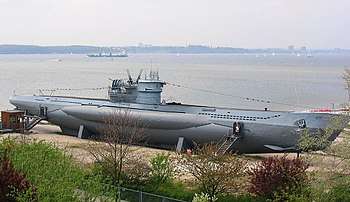German submarine U-1014
German submarine U-1014 was a Type VIIC/41 U-boat of Nazi Germany's Kriegsmarine during World War II.
 U-995 Type VIIC/41 at the Laboe Naval Memorial. This U-boat is almost identical to U-1014. | |
| History | |
|---|---|
| Name: | U-1014 |
| Ordered: | 23 March 1942 |
| Builder: | Blohm & Voss, Hamburg |
| Yard number: | 214 |
| Laid down: | 25 March 1943 |
| Launched: | 30 January 1944 |
| Commissioned: | 14 March 1944 |
| Fate: | Sunk, 4 February 1945 |
| General characteristics | |
| Type: | Type VIIC/41 submarine |
| Displacement: |
|
| Length: |
|
| Beam: |
|
| Height: | 9.60 m (31 ft 6 in) |
| Draught: | 4.74 m (15 ft 7 in) |
| Installed power: |
|
| Propulsion: |
|
| Speed: |
|
| Range: | |
| Test depth: |
|
| Complement: | 44-52 officers & ratings |
| Armament: |
|
| Service record | |
| Part of: |
|
| Commanders: | |
| Operations: | 1 patrol |
| Victories: | None |
She was ordered on 23 March 1942, and was laid down on 25 March 1943, at Blohm & Voss, Hamburg, as yard number 214. She was launched on 30 January 1944, and commissioned under the command of Oberleutnant zur See Wolfgang Glaser on 14 March 1944.[2]
Design
German Type VIIC/41 submarines were preceded by the heavier Type VIIC submarines. U-1014 had a displacement of 769 tonnes (757 long tons) when at the surface and 871 tonnes (857 long tons) while submerged. She had a total length of 67.10 m (220 ft 2 in), a pressure hull length of 50.50 m (165 ft 8 in), an overall beam of 6.20 m (20 ft 4 in), a height of 9.60 m (31 ft 6 in), and a draught of 4.74 m (15 ft 7 in). The submarine was powered by two Germaniawerft F46 four-stroke, six-cylinder supercharged diesel engines producing a total of 2,800 to 3,200 metric horsepower (2,060 to 2,350 kW; 2,760 to 3,160 shp) for use while surfaced, two BBC GG UB 720/8 double-acting electric motors producing a total of 750 metric horsepower (550 kW; 740 shp) for use while submerged. She had two shafts and two 1.23 m (4 ft) propellers. The boat was capable of operating at depths of up to 230 metres (750 ft).[3]
The submarine had a maximum surface speed of 17.7 knots (32.8 km/h; 20.4 mph) and a maximum submerged speed of 7.6 knots (14.1 km/h; 8.7 mph). When submerged, the boat could operate for 80 nautical miles (150 km; 92 mi) at 4 knots (7.4 km/h; 4.6 mph); when surfaced, she could travel 8,500 nautical miles (15,700 km; 9,800 mi) at 10 knots (19 km/h; 12 mph). U-1014 was fitted with five 53.3 cm (21 in) torpedo tubes (four fitted at the bow and one at the stern), fourteen torpedoes or 26 TMA or TMB Naval mines, one 8.8 cm (3.46 in) SK C/35 naval gun, (220 rounds), one 3.7 cm (1.5 in) Flak M42 and two 2 cm (0.79 in) C/30 anti-aircraft guns. The boat had a complement of between forty-four and fifty-two.[3]
Service history
U-1014 participated in one war patrol. Which resulted in no ships damaged or sunk.[2]
U-1014 rammed U-1015, her sister boat, on 19 May 1944, west of Pillau in the Baltic Sea. U-1015 sunk with the loss of 36 of her 40 crewmen.[2]
Two men were killed and three wounded on 16 September 1944, in the harbor of Libau, Latvia, during a Soviet air raid.
U-1014 had Schnorchel underwater-breathing apparatus fitted out before January 1945.[2]
On 4 February 1945, 18 days out of Horten, on her first, and only, war patrol, she was located by the British frigates Loch Scavaig, Nyasaland, Papua, and Loch Shin. U-1014 was sunk by depth charges in the North Channel, east of Malin Head, with all 48 of her crew.[2]
The wreck now lies at 55°17′N 06°44′W.
See also
References
- Helgason, Guðmundur. "Wolfgang Glaser". German U-boats of WWII - uboat.net. Retrieved 22 March 2016.
- Helgason, Guðmundur. "U-1014". German U-boats of WWII - uboat.net. Retrieved 22 March 2016.
- Gröner 1991, pp. 43-44.
Bibliography
- Busch, Rainer; Röll, Hans-Joachim (1999). German U-boat commanders of World War II : a biographical dictionary. Translated by Brooks, Geoffrey. London, Annapolis, Md: Greenhill Books, Naval Institute Press. ISBN 1-55750-186-6.CS1 maint: ref=harv (link)
- Busch, Rainer; Röll, Hans-Joachim (1999). Deutsche U-Boot-Verluste von September 1939 bis Mai 1945 [German U-boat losses from September 1939 to May 1945]. Der U-Boot-Krieg (in German). IV. Hamburg, Berlin, Bonn: Mittler. ISBN 3-8132-0514-2.
- Gröner, Erich; Jung, Dieter; Maass, Martin (1991). U-boats and Mine Warfare Vessels. German Warships 1815–1945. 2. Translated by Thomas, Keith; Magowan, Rachel. London: Conway Maritime Press. ISBN 0-85177-593-4.
External links
- Helgason, Guðmundur. "Patrols by U-1014". German U-boats of WWII - uboat.net.